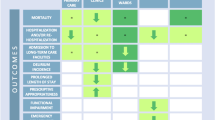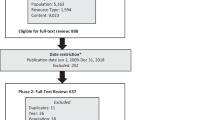Abstract
Summary
The leading causes of mortality in our study were pneumonia, diseases of the circulatory system, and dementias. In patients with hip fractures, the emphasis should be placed not only on measures to prevent falls and osteoporosis, but also on preventing functional decline and pneumonia.
Purpose
To describe the specific causes of death in patients who died up to 2 years after sustaining a hip fracture, how many of those deaths were directly related to the hip fracture, and the risk factors for mortality.
Methods
A retrospective review of the clinical data of all patients admitted with hip fractures between December 2009 and September 2015. Cause of death was classified according to the International Statistical Classification of Diseases and Related Health Problems (ICD10)
Results
In the first 2 years after hip fracture, 911 patients (32.7%) died. The leading causes of mortality were pneumonia 177 (19.4%), diseases of the circulatory system 146 (16%), and dementias 126 (13.9%). Thirty patients (3.2%) died from causes directly related to hip fracture or surgery. Mortality risk factors with a higher relative risk were advanced age, male sex, higher comorbidity, delirium, and medical complications during admission.
Conclusions
Pneumonia and circulatory system diseases were the commonest causes of death in our study. In patients with hip fractures, emphasis should be placed on preventing functional decline and pneumonia. In a few patients, death was directly related to the hip fracture, although decompensation of chronic illness as a result of hip fracture and fracture-related functional decline may have been indirect causes. Patients with worse conditions at admission had the highest risk of mortality.

Similar content being viewed by others
Change history
04 March 2021
A Correction to this paper has been published: https://doi.org/10.1007/s11657-021-00912-x
References
Schnell S, Friedman SM, Mendelson DA, Bingham KW, Kates SL (2010) The 1-year mortality of patients treated in a hip fracture program for elders. Geriatr Orthop Surg Rehabil 1(1):6–14. https://doi.org/10.1177/2151458510378105
Von Friesendorff M, Mc Guigan FE, Wizert A et al (2016) Hip fracture, mortality risk, and cause of death over two decades. Osteop Int 27(10):2945–2953. https://doi.org/10.1007/s00198-016-3616-5
Haentjens P, Magaziner J, Colón-Emeric CS et al (2010) Metaanalysis: excess mortality after hip fracture among older women and men. Ann Intern Med 152(6):380–390. https://doi.org/10.7326/0003-4819-152-6-201003160-00008
Panula J, Pihlajamäki H, Mattila V et al (2011) Mortality and cause of death in hip fracture patients aged 65 or older – a population-based study. BMC Muskuloskelet Disord 12:105. https://doi.org/10.1186/1471-2474-12-105
Gonzalez-Montalvo JI, Alarcon T, Hormigo Sanchez AI (2011) ¿Por qué fallecen los pacientes con fractura de cadera? Med Clin (Barc) 137(8):355–360. https://doi.org/10.1016/j.medcli.2010.07.005
Wehren LE, Hawkes WG, Orwig DL, Hebel R, Zimmerman SI, Magaziner J (2003) Gender differences in mortality after hip fracture: the role of infection. J Bone Miner Res 18(12):2231–2237. https://doi.org/10.1359/jbmr.2003.18.12.2231
Chatterton BD, Moores TS, Ahmad S, Cattell A, Roberts PJ (2015) Cause of death and factors associated with early in-hospital mortality after hip fracture. Bone Joint J 97-B(2):246–251. https://doi.org/10.1302/0301-620X.97B2.35248
Muraki S, Yamamoto S, Ishibashi H, Nakamura K (2006) Factors associated with mortality following hip fracture in Japan. J Bone Miner Metab 24(2):100–104. https://doi.org/10.1007/s00774-005-0654-z
Charlson ME, Pompei P, Ales KL, MacKenzie CR (1987) A new method of classifying prognostic comorbidity in longitudinal studies: development and validation. J Chronic Dis. 40(5):373–383
Mahoney F, Barthel D (1965) Functional evaluation: the Barthel Index. Md Med J. 14:61–65
Wordl Health Organisation (1992) The International Statistical Classification of Diseases and Related Health Problems, Tenth Revision. WHO, Geneva
Perez J, Warwick DJ, Case CP, Bannister GC (1995) Death after proximal femoral fracture—an autopsy study. Injury. 26(4):237–240. https://doi.org/10.1016/0020-1383(95)90008-I
McNamara I, Sharma A, Prevost T, Parker M (2009) Symptomatic venous thromboembolism following a hip fracture. Acta Orthop 80(6):687–692. https://doi.org/10.3109/17453670903448273
Shin WC, Lee SM, Suh KT (2017) Recent updates of the diagnosis and prevention of venous thromboembolism in patients with a hip fracture. Hip pelvis 29(3):159–167. https://doi.org/10.5371/hp.2017.29.3.159
Torres OH, Gil E, Pacho C, Ruiz D (2013) Actualización de la neumonía en el anciano. Rev Esp Geriatr Gerontol. 48(2):72–78. https://doi.org/10.1016/j.regg.2012.06.001
Chang SC, Lai JI, Lu MC, Lin KH, Wang WS, Lo SS, Lai YC (2018) Reduction in the incidence of pneumonia in elderly patients after hip fracture surgery: An inpatient pulmonary rehabilitation program. Medicine. 97(33):e11845. https://doi.org/10.1097/MD.0000000000011845
Shariatzadeh MR, Huang JQ, Marrie TJ (2006) Differences in the features of aspiration pneumonia according to site of acquisition: community or continuing care facility. J Am Geriatr Soc. 54:296–302. https://doi.org/10.1111/j.1532-5415.2005.00608.x
Metani H, Tsubahara A, Hiraoka T, Seki S, Hasegawa T (2015) Risk factor for patients who develop pneumonia either before or after hip fracture surgery. Jpn J Compr Rehabil Sci 6:43–49. https://doi.org/10.11336/jjcrs.6.43
Teramoto S, Fukuchi Y, Sasaki H, Sato K, Sekizawa K, Matsuse T (2008) High incidence of aspiration pneumonia in community-and hospital-acquired pneumonia in hospitalized patients: a multicenter, prospective study in Japan. J Am Geriatr Soc. 56(3):577–579. https://doi.org/10.1111/j.1532-5415.2008.01597.x
Baijens LWJ, Clave P, Cras P et al (2016) European Society for Swallowing Disorders- European Union Geriatric Medicine Society white paper: oropharyngeal dysphagia as a geriàtric syndrome. Clin Interv Aging 11:1403–1428. https://doi.org/10.2147/CIA.S107750
Malafarina V, Reginster JY, Cabrerizo S et al (2018) Nutritional Status and Nutritional Treatment Are Related to Outcomes and Mortality in Older Adults with Hip Fracture. Nutrients 10(5):555. Published 2018 Apr 30. https://doi.org/10.3390/nu10050555
Sheik HQ, Hossain FS, Aqil A, Akinbamijo B, Mushtaq V, Kapoor H (2017) A comprehensive analysis of the causes and predictors of 30-day mortality following hip fracture surgery. Clin Orthop Surg 9(1):10–18. https://doi.org/10.4055/cios.2017.9.1.10
Desai SJ, Wood KS, Marsh J, Bryant D, Abdo H, Lawendy AR, Sanders DW. (2014) Factors affecting transfusion requirement after hip fracture: can we reduce the need for blood? Can J Surg 2014, 57(5): 342–348. https://doi.org/10.1503/cjs.030413
Marcantonio ER, Flacker JM, Michaels M, Resnick NM (2000) Delirium is independently associated with poor functional recovery alter hip fracture. J Am Geriatr Soc. 48(6):618–624. https://doi.org/10.1111/j.1532-5415.2000.tb04718.x
Martocchia A, Curto M, Comite F et al (2015) Orthogeriatric Group. Recent Pat CNS Drug Discov. 10(1):55–64. https://doi.org/10.2174/1574889810666150216152624.
Shields L, Henderson V, Caslake R (2017) Comprehensive geriatric assessment for prevention of delirium after hip fracture: a systematic review of randomized controlled trials. J Am Geriatr Soc 65(7):1559–1565. https://doi.org/10.1111/jgs.14846
Cameron ID, Chen JS, March LM et al (2010) Hip fracture causes excess mortality owing to cardiovascular and infectious disease in institutionalized older people: a prospective 5-year study. J Bone Miner Res 4:866–872. https://doi.org/10.1359/jbmr.091029
Acknowledgments
We would like to thank Janet Gaynor Dawson for her help with the English in this paper and Ignasi Gich for his statistical assessment.
Author information
Authors and Affiliations
Corresponding author
Ethics declarations
Conflicts of interest
None.
Ethical approval
The study was approved by the institutional ethics committee (IIBSP-FEM-2018-18). All procedures performed in studies involving human participants were in accordance with the ethical standards of the institutional and/or national research committee and the 1964 Helsinki Declaration and its later amendments or comparable ethical standards.
Informed consent
For this type of study, formal consent is not required
Additional information
Publisher’s note
Springer Nature remains neutral with regard to jurisdictional claims in published maps and institutional affiliations.
Rights and permissions
About this article
Cite this article
Barceló, M., Torres, O.H., Mascaró, J. et al. Hip fracture and mortality: study of specific causes of death and risk factors. Arch Osteoporos 16, 15 (2021). https://doi.org/10.1007/s11657-020-00873-7
Received:
Accepted:
Published:
DOI: https://doi.org/10.1007/s11657-020-00873-7




